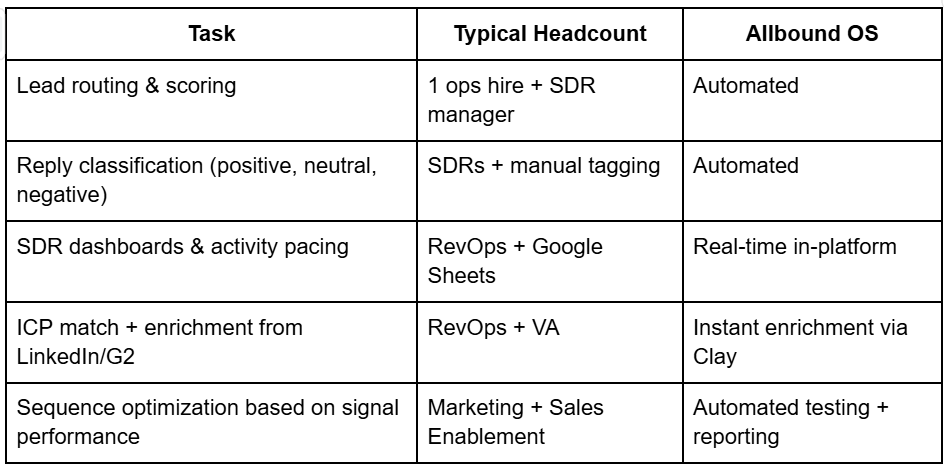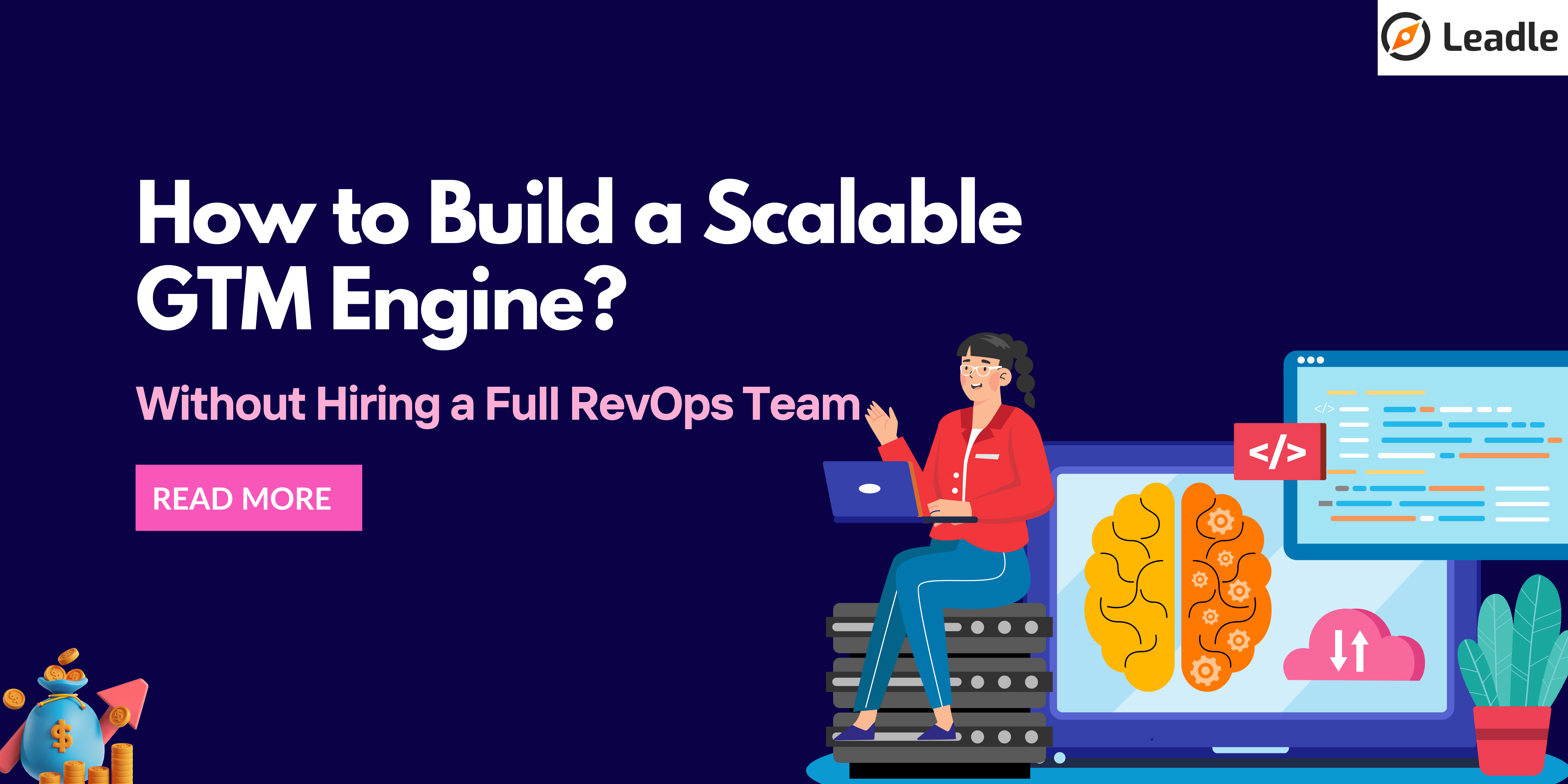Most B2B founders hit a breaking point where RevOps feels like the answer.
Leads are slipping through the cracks. CRM is a mess. Your AE is working 40 leads manually. Dashboards aren’t telling you anything useful.
So the default reaction is:
“We need to hire RevOps.”
But in most early to mid-stage teams, that hire is premature.
Because, what’s broken isn’t the lack of a person, it’s the lack of a system that scales.
In this post, we’ll break down:
- What RevOps actually owns (and what it doesn't)
- When to hire and when to automate
- The decision-making framework we use with clients
- How Allbound OS gives you RevOps-level clarity without full-time headcount
Let’s clear the fog.
What Revenue Operations Actually Does (And Why It’s Often Misunderstood)
RevOps is not a glorified CRM admin. And it’s not just sales ops with a new title.
An ideal RevOps function:
✅Designs and owns full-funnel visibility (from lead to renewal)
✅Aligns sales, marketing, CS, and partnerships
✅Builds systems that scale: routing, attribution, forecasting, workflows
✅Creates feedback loops across the GTM team
✅Surfaces actionable data so you can scale what’s working and fix what’s not
It’s strategy + systems + data ownership.
But when founders hire RevOps too early, they often end up with:
An ops generalist who's overwhelmed
Strategy still living in the founder's head
Tool chaos no one fully owns
Also Read - How to Implement RevOps in SaaS Startups: A Scalable Framework for Revenue Growth
Automation vs RevOps: A Framework to Decide
So, how do you know if you need a full-time hire or if automation will do?
Use this 3-part lens:

Bottomline:
Automation can buy you 6–18 months of scale before RevOps needs to step in.
When You Actually Need a RevOps Hire
Hiring RevOps too early feels strategic, but it just adds headcount without solving root issues.
So what are the real triggers?
✅ You have data, but no one owns the insights
You’re sitting on reports, dashboards, and attribution models, but no decisions are being made from them.
✅ Your GTM motion is scaling faster than your systems
Inbound, outbound, partnerships, all producing traction, but ops is lagging.
✅ There’s constant misalignment
SDRs are chasing low-fit leads. CS doesn’t know what Sales promised. Leadership debates metrics every week.
✅ Manual work is slowing velocity
Reps spend time updating fields, tagging contacts, pulling reports. Forecasting takes 3 hours and a spreadsheet.
✅ You’re ready to shift from founder-led GTM to team-led scale
This is usually around late Seed to Series B. You’re hiring specialists and need foundational architecture.
But here’s the key: if you don’t have a system in place, hiring RevOps won’t solve chaos. It will just institutionalize it.
When Automation Fits the Bill (And Saves You From Premature Hiring)
Automation is not just about saving time.
It’s about creating a system that thinks, acts, and evolves, even when no one’s looking.
Here’s where automation is a better fit than a hire:
✅ You’re still testing GTM motions
Automation lets you iterate fast without needing someone to manually rewire things.
✅ You need routing, enrichment, and dashboards — not RevOps strategy
That’s 80% of most early-stage RevOps needs.
✅ You want to scale outreach, not complexity
Trigger-based outbound, signal-based LinkedIn flows, and automated lead scoring go further than another spreadsheet jockey.
✅ You’re building clarity before headcount
Automation sets a clean foundation. So when you do hire, your RevOps person builds on strong bones.
What a Scalable GTM System Should Feel Like
Here’s what your GTM engine should deliver with or without a RevOps hire:
- Signals from your CRM, website, LinkedIn, G2, and outbound tools feed into one place
- Auto-prioritization of accounts based on fit and behavior
- Triggered playbooks run based on persona, funnel stage, and intent
- Dashboards tell you why deals are stalling, not just how many
- Routing logic evolves without requiring 10 clicks in HubSpot
And when things start slipping? The system flags it. The team adjusts. And nobody is surprised.
How Allbound OS Bridges the Gap
This is exactly why we built Allbound OS.
We saw B2B teams burning cash on:
→ CRM consultants
→ Half-baked sales enablement tools
→ Manual lead sorting and enrichment
→ Dashboards that only make sense to the RevOps person who built them
Instead, we built a system that does this:
→ Automated Routing & Scoring
Leads, demo requests, outbound replies — all enriched, scored, and routed in real-time based on your ICP.
→ Signal-Driven Outbound & ABM
Trigger LinkedIn and email sequences based on:
- Job changes
- Website visits
- CRM activity
- Intent signals
→ Live Dashboards That Drive Action
Monitor reply rates, campaign velocity, channel ROI all in one view. Not just activity reports, but insight loops that fuel growth.
→ Workflow Templates Built for Scale
Plug-and-play GTM workflows for:
- Outbound follow-ups
- Demo no-show sequences
- Intent-based retargeting
- SDR capacity and accountability
All of this runs without a full RevOps team. It’s RevOps as a system, not just a person.
A Few Real Workflows We Automate That Usually Require RevOps

Final Take: Build the System Before You Hire the Person
You don’t need to hire RevOps to start building revenue infrastructure.
You need to install leverage.
Start by asking:
→ Is your current system showing you where growth is breaking?
→ Do your GTM motions run without constant manual upkeep?
→ Can your team take action based on what the data is telling them?
If not, don’t hire RevOps yet.
Build a system that gives your future RevOps hire something worth optimizing.
Suraj
COO - Leadle





